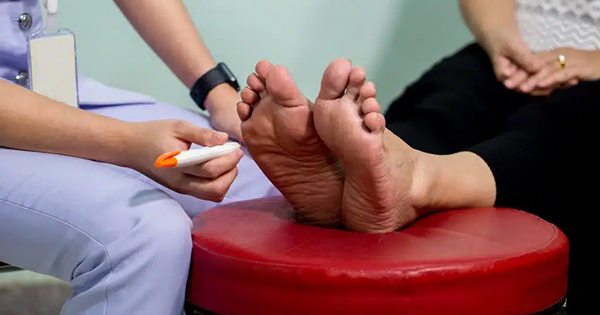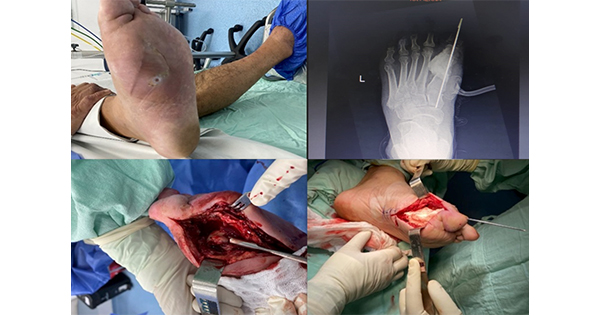A hand-held Doppler probe is a small, portable ultrasound machine designed to detect blood flow. It works by transmitting high frequency sound waves (typically 8–10MHz) through the tissues and collecting the reflected signal.
Any change in frequency between the transmitted and reflected signals indicates that the ultrasound beam must have been reflected off a moving target, i.e. moving blood cells.
The change in frequency detected by the Doppler machine is output as an audible signal (sound), and it is this sound which indicates the presence of blood flow to the operator.
The Doppler signal can be used in many ways. For example, it can be plotted on a graph so waveform shape can be analysed. However, one of the simplest methods of assessing peripheral vascular status – measurement of systolic pressures in the peripheral arteries of the ankle and arm – relies solely on sound.
Comparison of systolic pressure measured at the ankle with that measured more centrally (the brachial artery) gives an indication of the severity of peripheral vascular disease.
The ratio of systolic pressure in the ankle to that in the brachial artery is known as the ankle–brachial pressure index (ABPI).
Measuring the ABPI
Equipment (Figure 1)
- Doppler machine: This must be in good working order, with a charged battery, to give the loudest signal
- Ultrasound gel: This provides a coupling medium that allows the transmission of ultrasound between the probe and tissue
- Sphygmomanometer: This needs to be calibrated regularly for accurate pressure measurements
- Calculator: Only the basic division function is required.
Method
Before beginning any measurement, ensure that the patient is lying supine and has been resting for at least 10 minutes.
Wrap the cuff of the sphygmomanometer snugly around the left ankle with the tubing towards the head, avoiding any ulcerated areas (Figure 2).
Apply a small quantity of ultrasound gel to the skin overlying the approximate pulse position. Place the Doppler probe tip in the gel, applying gentle pressure, and then turn the machine on.
Perform slow, sweeping movements of the probe (holding it like a pen for maximum control) to locate the artery, which will be detected as a pulsating or beating sound. It is important to do this carefully, using the sound to guide you onto the vessel (the posterior tibial pulse lies behind the medial malleolus, a little down towards the heel; the dorsalis pedis pulse may be detected at the ankle crease or over the instep).
Once you have a signal, make sure that this is as clear and sharp as possible by carefully tilting and manipulating the probe. Ideally the probe should be inclined at 60˚ to the main axis of the artery. When the signal is at its strongest, measure the pressure (posterior tibial and dorsalis pedis pulses; Figure 3).
Concentrating on maintaining the Doppler probe position, gradually inflate the cuff of the sphygmomanometer until the signal disappears; then turn your attention to the pressure gauge and slowly release some of the air.
Record the pressure at which the first Doppler signal returns – this is the systolic pressure. Continue to release the air while listening to the signal to ensure that you have not accidentally moved off the vessel (Figure 4).
It is essential to take pressure readings from both the dorsalis pedis and the posterior tibial arteries in each foot. Once both readings have been obtained from the left ankle, repeat the procedure on the right ankle (Figure 5).
The final measurements needed to calculate the ABPIs are the brachial pressures; these must be measured using the Doppler probe and not a stethoscope.
Wrap the sphygmomanometer cuff around the left arm with the tubing towards the head. Apply some gel over the brachial artery in the antecubital fossa and then find the pulse with the Doppler probe; this should be a strong signal, so take a little time to achieve the best probe position.
As before, watch the Doppler probe as you inflate the cuff. Once the sound disappears, look at the sphygmomanometer and gradually release the pressure, recording the value when the first signal returns. Repeat for the right arm (Figures 6 and 7).
Calculating the ABPI
The ABPI is calculated for each limb separately.
Considering one leg at a time, compare the pressure readings for the posterior tibial and dorsalis pedis arteries in that leg and choose whichever value is the highest. Then divide this pressure measurement by the highest of the two (right and left) brachial pressures (see box below).
Interpreting the ABPI
The ABPI is a comparison of systolic blood pressure in the ankle and central systolic blood pressure (brachial artery).
In the absence of significant peripheral vascular disease, these pressures should be similar, giving an ABPI of approximately 1.0 (range 0.9–1.3).
However, any narrowing (stenosis) or blockage in the arteries in the legs will cause a drop in pressure and so the ABPI will be reduced (<0.9), i.e. the pressure recorded at the ankle will be significantly lower than central (brachial) arterial pressure.
The ABPI therefore provides a guide to the severity of disease. A very low ABPI (<0.5) indicates severe peripheral vascular disease and the patient requires urgent referral to a vascular clinic.
A guide to the interpretation of ABPI values is shown in Table 1.
Patients with diabetes
Patients with diabetes commonly develop calcification of their peripheral arteries as a consequence of the disease. This process may be exacerbated by smoking and other factors.
When the calcification is severe, the arterial wall becomes stiff or rigid, and resistant to external compression. This means that the arterial walls will not be easily compressed by the cuff. Thus, when the blood pressure cuff is inflated around the ankle, it is the stiffness of the arterial walls that is being measured rather than the pressure of the blood within the artery.
This results in an abnormally high reading at the ankle (and an ABPI >1.3), preventing accurate assessment of peripheral vascular disease by this method. When this occurs, alternative techniques, such as toe pressures, or the Pole test, should be used.
Pitfalls
Inaccuracies in any or all of the pressures measured can occur at several stages, so care must be taken to minimise errors.
Patient position: Patients should lie as flat as possible. If they cannot lie flat, then they need to be made comfortable and their position noted in the records.
When taking a pressure measurement, the limb should ideally be at heart height; if it is raised or lowered compared with the heart, the blood pressure may be underestimated or overestimated respectively.
Cuff size: Obese patients or those with oedematous limbs may require a larger size of cuff. If too small a cuff is used, a falsely high reading will be obtained. Check that the cuff wraps around each limb within the range finder marked on it.
Poor Doppler signal: If the signals obtained are extremely weak, including those from the brachial arteries, it may be that insufficient gel has been used, or that the probe is being applied too firmly and the vessel is being occluded.
If the signals remain weak once these problems have been rectified, it is likely that the Doppler battery is low and this must be recharged or replaced as appropriate.
Venous noise: Two veins run alongside each of the arteries in the calf and give rise to a slow, rumbling noise which can interfere with the arterial signal. However, once the cuff has been inflated above venous pressure, this sound will disappear.
Variable readings: Repeated inflation of the cuff around a limb will cause the pressure to fall. If a reading is difficult to obtain, deflate the cuff fully and wait for a few minutes before trying again.
Summary
Measurement of the ABPI by a hand-held Doppler probe is a quick and simple method of assessing the arterial circulation. With practice, a complete assessment can be performed in approximately 10 minutes.
Once the practitioner is familiar with the sounds produced by the Doppler probe, it is possible to distinguish between normal triphasic waveforms and damped, monophasic signals which indicate significant peripheral artery disease. This is particularly useful for the minority of cases where calcification of the tibial arteries precludes meaningful interpretation of the ABPI; alternative techniques such as toe pressures or the Pole test can provide further information.
For patients with a normal ABPI but who describe symptoms of claudication, the sensitivity of the test can be increased by performing an exercise test. Walking increases the blood flow, resulting in an increased pressure drop across an arterial narrowing. Thus, post exercise, the ABPI will be significantly reduced (<0.9) where there is true claudication due to arterial obstruction, but remain normal if the symptoms are due to other causes such as lumbar canal stenosis.
As a tool for investigating peripheral vascular disease, the hand-held Doppler probe is invaluable. It is small, highly portable and easy to use. It allows quick identification of patients without significant peripheral vascular disease and those requiring further investigation; it also has applications in the assessment of venous disease.
Thus, Doppler studies have an essential role to play in the investigation of peripheral vascular disease.
Publisher’s note
Figures 1–7 are not available in the online version.





